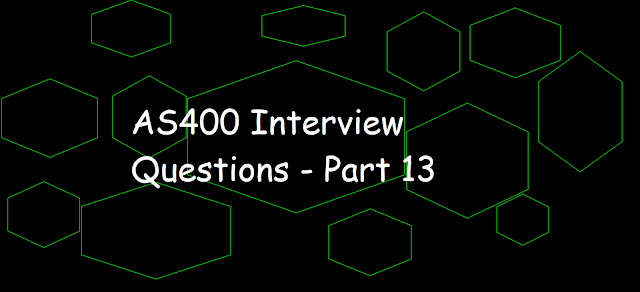Q1: Can you define 2 QSYSPRT in a single program?
Answer:
- No, Only one.
Q2: How can we display an empty subfile?
Answer:
- SFLDSP keyword - Indicator OFF
Q3: When do you get Data Decimal Error?
Answer:
- The numeric field contains garbage data in files.
- The numeric field in the RPG program is not initialized.
Q4: What are the Types of Subfiles?
Answer:
- Load all subfile
- Expandable subfile
- Single page subfile
Q5: What are Subfile mandatory keywords?
Answer:
- SFL
- SFLCTL
- SFLDSP
- SFLPAG
- SFLSIZ
Q6: What is the difference between SFLCLR and SFLINZ?
Answer:
- SFLCLR - clears the data loaded on Subfile.
- SFLINZ - clears the data loaded on Subfile and then initialized the character fields with blank and numeric fields with zero.
Q7: Difference between EXCPT and WRITE?
Answer:
- EXCEPT - Used in O specs program described PRTF o write on PRTF or Database file.
- WRITE - Write to the database file, device files.
Q8: What is CLEAR and RESET?
Answer:
- CLEAR - To clear the value in a variable in the RPG program and it sets the value to the Low value.
- RESET - will reset its Initialized value to the original initialized value in the INZ keyword.
Q9: What is the Binding directory?
Answer:
- BNDDIR contains a list of service programs and modules.
- It is just like a library list.
Q10: When do we receive Signature Violation Error?
Answer:
- The signature of the Service program does not match with the signature saved in the calling program.
Q11: What is binder language in simple terms?
Answer:
- Binder language lists out the exported procedures from the SRVPGM.
Q12: What are program entry procedures (PEP) and user entry procedures (UEP)?
Answer:
- PEP, If a program is created using multiple modules, then which module to execute first. So the name of the module mentioned in PEP will be executed first.
- UEP, The first statement takes the control in that module while executing the program.
Q13: How do you export and import any data between the two programs?
Answer:
- Use EXPORT and IMPORT keywords.
- The module must be bound to the programs to achieve this.
Q14: Which command is used to replace modules of an ILE bound program with other modules on the system, without recompiling the bound program?
Answer:
- UPDPGM
Q15: What is the difference between CALL, CALLB, and CALLP?
Answer:
- CALL - dynamic call, calling PPGMB from PGMA. control transfers to PGMB
- CALLB - prototyped call, calling a module having no procedure i.e. having default procedure.
- CALLP - prototyped call, calling a NOMAIN module with several procedures
Q16: What is the command which we use to build a service program?
Answer:
- CRTSRVPGM
Q17: What is bind by reference?
Answer:
- Creating a module and binding it to SRVPGM and then we are using that SRVPGM into some of the programs then this method is called as bind be the reference.
Q18: What is bind by copy?
Answer:
- Creating a module and binding it to PGM directly is bind by copy. At any time, we can delete the module and take the PGM to any other machine and execute that. So we don't need the module since all the references to the module are already copied to PGM.
Q19: What is a module?
Answer:
- A module is a Non-executable object.
Q20: What is the Activation group in ILE?
Answer:
- Sub-structure of the Job or resource container within a Job.
- Activation groups are *NEW, *CALLER, NAMED, *ENTMOD
- *NEW - when the program gets called a new activation group gets created.
- *CALLER - when the program gets called the program is activated into the caller activation group.
- NAMED - Specify the name of the activation group to be used when this program is called.
- *ENTMOD - The program entry procedure module(ENTMOD parameter) is checked and if the storage model is *SNGLVL then the Activation group is QILE and if the storage model is *TERASPACE then the Activation group is QILETS.
- We can specify the Activation group while creating programs or service programs.
- CRTACTGRP command is used to create an activation group.
- Default Activation group must be *NO in case of ILE objects.
Related Post
AS400 Interview Questions - Part 1
AS400 Interview Questions - Part 2
AS400 Interview Questions - Part 3
AS400 Interview Questions - Part 4
AS400 Interview Questions - Part 5
AS400 Interview Questions - Part 6
AS400 Interview Questions - Part 7
AS400 Interview Questions - Part 8
AS400 Interview Questions - Part 9
AS400 Interview Questions - Part 10
AS400 Interview Questions - Part 11
AS400 Interview Questions - Part 12
AS400 Interview Questions (DB2) - Part 1
AS400 Interview Questions (DB2) - Part 2
